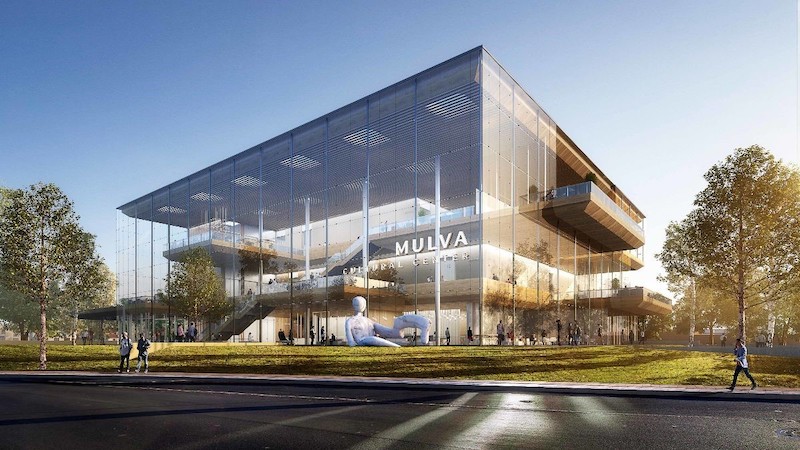The City of De Pere, Wis., began in the 17th century as a fishing village with a monastery, grew to be an incorporated city by the 1860s and has a National Register of Historic Places historic district with dozens of homes in a variety of styles that were built from the early 19th to early 20th centuries.
That architectural legacy is only part of what makes the small city attractive to some. Now, thanks to the generosity of James and Miriam Mulva, who have in recent years donated tens of millions of dollars to various groups, a new artistic focal point will draw new visitors, and enliven the historic town.
The wife and husband philanthropists recently announced designs for the Mulva Cultural Center, which will be in De Pere. The building will have an exterior made of transparent glass and will be a setting of arts activities and a focal point of the city’s arts community.
See Also: Puerto Rican mixed-use, mixed income housing development begins construction
Designed by the Skidmore, Owings & Merrill architecture firm (SOM), the center will be situated along the Fox River.
“The hiring of SOM as the architect for the Mulva Cultural Center shows just how significant this project is for the City of De Pere and the people of Northeast Wisconsin. It underscores our family’s longstanding commitment to enhancing the community my wife Miriam and I have known and loved since our childhood,” says Jim Mulva. “We are honored and thrilled to partner with SOM on what is a grand plan for bringing this addition to the heart of historic downtown De Pere as part of the city’s new Cultural District Master Plan.”
The 60,000-square-foot center will host traveling art exhibitions, provide cultural programming and educational programming, and host other activities. The plans for the center follow a long-term strategy for the future of the city, which is in the Greater Green Bay Area.
“As a city, we have always been incredibly proud of our rich history and traditions while also endlessly striving to build a vibrant and forward-thinking future,” says De Pere Mayor Mike Walsh. “The Mulva Cultural Center embodies that spirit. We look forward to this world-class addition, and we are grateful for this significant opportunity to enrich and grow our community.”
The Mulva Cultural Center will have an open-air atrium spanning the building’s three stories., and a large auditorium. The center also will have flexible permanent and temporary exhibition spaces, event space, classrooms, a café, and an outdoor terrace.
Related Stories
| Aug 11, 2010
Curtain rises on Broadway's first green theater
The Durst Organization and Bank of America have opened New York's first LEED-certified theater, the 1,055-seat Henry Miller's Theatre. Located inside the new 55-story Bank of America Tower at One Bryant Park, the 50,000-sf theater is located behind the preserved and restored neo-Georgian façade of the original 1918 theater.
| Aug 11, 2010
Restoration gives new life to New Formalism icon
The $30 million upgrade, restoration, and expansion of the Mark Taper Forum in Los Angeles was completed by the team of Rios Clementi Hale Studios (architect), Harley Ellis Devereaux (executive architect/MEP), KPFF (structural engineer), and Taisei Construction (GC). Work on the Welton Becket-designed 1967 complex included an overhaul of the auditorium, lighting, and acoustics.
| Aug 11, 2010
Concrete Solutions
About five or six years ago, officials at the University of California at Berkeley came to the conclusion that they needed to build a proper home for the university's collection of 900,000 rare Chinese, Japanese, and Korean books and materials. East Asian studies is an important curriculum at Berkeley, with more than 70 scholars teaching some 200 courses devoted to the topic, and Berkeley's pro...
| Aug 11, 2010
Piano's 'Flying Carpet'
Italian architect Renzo Piano refers to his $294 million, 264,000-sf Modern Wing of the Art Institute of Chicago as a “temple of light.” That's all well and good, but how did Piano and the engineers from London-based Arup create an almost entirely naturally lit interior while still protecting the priceless works of art in the Institute's third-floor galleries from dangerous ultravio...
Cultural Facilities | Aug 11, 2010
12 major trends in library design
Many academic planners assumed that the coming of the Internet would lead to the decline of the library as we know it. To the contrary, many academic libraries have experienced significantly increased patron use in recent years.
| Aug 11, 2010
Bronze Award: John G. Shedd Aquarium, Chicago, Ill.
To complete the $55 million renovation of the historic John G. Shedd Aquarium in the allotted 17-month schedule, the Building Team had to move fast to renovate and update exhibit and back-of-house maintenance spaces, expand the visitor group holding area, upgrade the mechanical systems, and construct a single-story steel structure on top of the existing oceanarium to accommodate staff office sp...
| Aug 11, 2010
Great Solutions: Green Building
27. Next-Generation Green Roofs Sprout up in New York New York is not particularly known for its green roofs, but two recent projects may put the Big Apple on the map. In spring 2010, the Lincoln Center for the Performing Arts will debut one of the nation's first fully walkable green roofs. Located across from the Juilliard School in Lincoln Center's North Plaza, Illumination Lawn will consist ...
| Aug 11, 2010
Idea Center at Playhouse Square: A better idea
Through a unique partnership between a public media organization and a performing arts/education entity, a historic building in the heart of downtown Cleveland has been renovated as a model of sustainability and architectural innovation. Playhouse Square, which had been working for more than 30 years to revitalize the city's arts district, teamed up with ideastream, a newly formed media group t...
| Aug 11, 2010
Divine intervention
Designed by H. H. Richardson in the 1870s to serve the city's burgeoning Back Bay neighborhood, Trinity Church in the City of Boston would come to represent the essence of the Richardsonian Romanesque style, with its clay tile roof, abundant use of polychromy, rough-faced stone, heavy arches, and massive size.
| Aug 11, 2010
Dream Fields, Lone Star Style
How important are athletic programs to U.S. school districts? Here's one leading indicator: In 2005, the National Football League sold 17 million tickets. That same year, America's high schools sold an estimated 225 million tickets to football games, according to the American Football Coaches Association.








